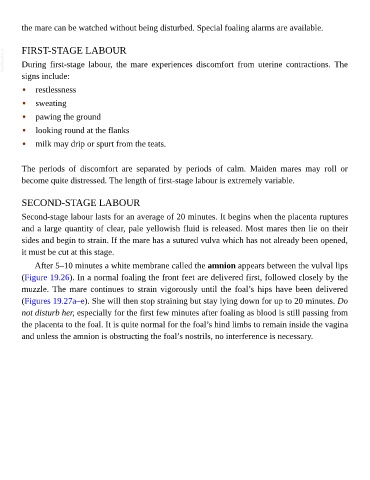Page 952 - The Veterinary Care of the Horse
P. 952
the mare can be watched without being disturbed. Special foaling alarms are available.
VetBooks.ir FIRST-STAGE LABOUR
During first-stage labour, the mare experiences discomfort from uterine contractions. The
signs include:
• restlessness
• sweating
• pawing the ground
• looking round at the flanks
• milk may drip or spurt from the teats.
The periods of discomfort are separated by periods of calm. Maiden mares may roll or
become quite distressed. The length of first-stage labour is extremely variable.
SECOND-STAGE LABOUR
Second-stage labour lasts for an average of 20 minutes. It begins when the placenta ruptures
and a large quantity of clear, pale yellowish fluid is released. Most mares then lie on their
sides and begin to strain. If the mare has a sutured vulva which has not already been opened,
it must be cut at this stage.
After 5–10 minutes a white membrane called the amnion appears between the vulval lips
(Figure 19.26). In a normal foaling the front feet are delivered first, followed closely by the
muzzle. The mare continues to strain vigorously until the foal’s hips have been delivered
(Figures 19.27a–e). She will then stop straining but stay lying down for up to 20 minutes. Do
not disturb her, especially for the first few minutes after foaling as blood is still passing from
the placenta to the foal. It is quite normal for the foal’s hind limbs to remain inside the vagina
and unless the amnion is obstructing the foal’s nostrils, no interference is necessary.

